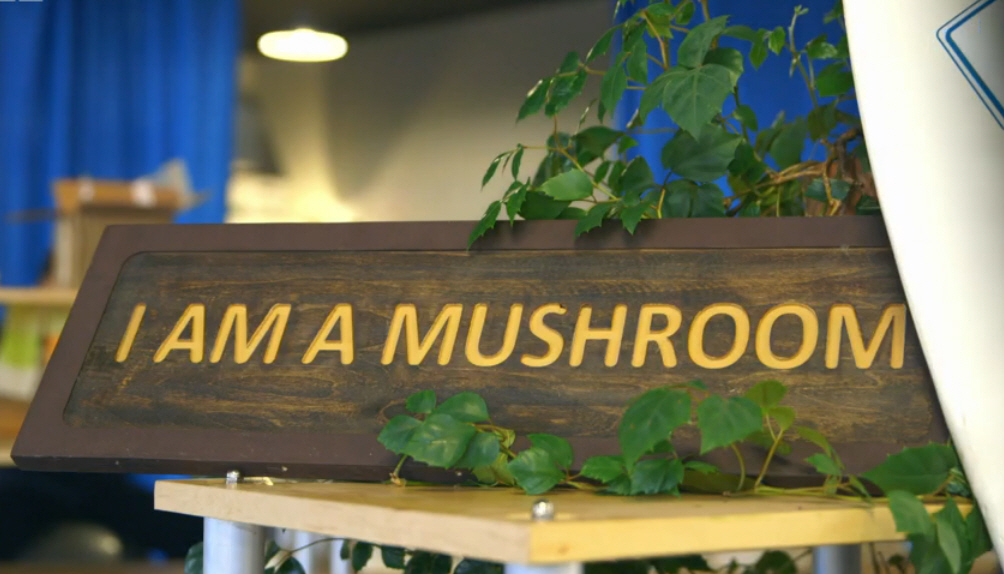Mycelium Marvel of Organic Packaging
Eben Bayer Entrepreneur

This is Eben Bayer, an entrepreneur based in New York. He noticed something intriguing that happens when some mycelium spreads out in search of food.
Eben Bayer “First time I saw mycelium in action was holding clumps of woodchips together on my family farm and rather than falling apart, they’d be held together by these white fibre strands. One night, sitting at home on my futon in my apartment, I got this crazy idea about, Hey, mycelium seems to grow, and glue the forest floor together. Maybe we can use it as a glue.”
Eben Bayer saw huge potential in this binding property of mycelium. He used it to create a new kind of packaging, one that he believes could, ultimately, become an eco-friendly alternative to some plastics.
Eben Bayer “Just in packaging alone, there’s like billions of dollars of Stryofoam used every year, somewhere between 3.5 and 5 billion of styrene, and the biggest issue with plastics is at their end of life and with our material, you get something that, at the end of its useful life, can be composted, right. Your packaging becomes a nutrient for your neighbourhood, not a pollutant.”
To make his new material, Eben mimics what happens in nature. He takes some ground corn stalks and seeds them with fungus spores. The spores germinate, and begin to feed on the stalks, breaking down and digesting them, so the mycelium can start to grow. The mixture is then placed inside a mould and left for the mycelium to perform its biological magic.
Eben Bayer “So, they’ll sit on a rack like this for anywhere from 24 to 72 hours. It doesn’t look like anything’s happening, but the mycelium is already going to work, growing and extending out from every one of these particles and building a strong, tough network. And within 24 hours, this part will look a little white and that’s the mycelium gluing everything together. So this is a finished corner block. It’s been grown in our production process, it’s been moulded and all this came from that loosie-goosie agricultural by-productyou saw at the beginning. It’s pretty incredible, huh?”
Eben Mayer “What we’ve done with mycelium here, which is basically leveraging a living organism to create really great technology, is where the excitement is, that’s where the innovation is and that’s where the solutions are going to be for the next 100 years.”
So the mushroom mycelium could help us tackle the global problem of plastic waste. But Eben’s work also demonstrates another important trait of the feeding mycelium. While some fungi feed on living organisms, others only eat those that are dead. These fungi are able to break down and digest organic waste and in doing so, recycle it. This process is called saprotrophy and it’s absolutely vital in the natural world.
In this damp wood, the litter of leaves, indeed, every twig, is being consumed by mycelium, that breaks down the cellulose and other compounds. Even wood can be digested by fungi. The hard lining that gives the wood its strength can be consumed and the wood reduced to little more than rubble. Were it not for the relentless activity of mycelium, in fact, the whole planet would be covered with a mass of undigested scrub.
It’s hard to overstate the importance of saprotrophic fungi. They have sucessfully recycled the world’s natural waste for hundreds of millions of years, making entire ecosystems habitable for animal and plant life. So how do they achieve this crucial trick?
So, Patrick, let’s talk rot.
Few people realise just how important those saprotropes fungi are in nature. How does it work?
Patrick Hickey “Well, fungi are really quite invasive. The fungi have this mycelium, which penetrates deep into the waste and unlike us, where our stomachs are internal, the fungi secrete their digestive juices out into the environment and start breaking down the complex molecules, things like cellulose, into more simple forms.”
This is via a myriad of those little hyphal threads.
Patrick Hickey “That’s right. And to demonstrate just how effective saprotrophic fungi are at breaking down organic matter, I’ve put several days of kitchen waste into this beaker and I’ve filmed it over two weeks to see just how quickly it goes down, it rots down.”
So, there it is, just sinking down.
Patrick Hickey “Yeah. Lots of juice exuding from the vegetables.”
So the invisible threads of the mycelium are getting in there, breaking the vegetables and the other organic waste, into something they can use.
Patrick Hickey “The other important thing to note here is that when all these vegetables did go into the beaker, they already had spores on them, so they were already pre-seeded with the spores.”
Because spores are everywhere.
Patrick Hickey “Exactly, when you bring the food back from the supermarket, it’ll already have a coating of a whole cocktail of different spores and as soon as those fungi are in a slightly warm environment, it becomes quite a feeding frenzy, if you like. So, Richard, I’m going to show you the results of the one that I prepared two weeks ago.”
Well, it couldn’t be much clearer than that.
Patrick Hickey “If this process wasn’t happening we would just be surrounded by organic waste matter.”
What it does show is just what makes the fungi such efficient seekers after… scavengers after nutrition.
The brilliant way the mycelium of a saprotrophic fungus uses digestive juices, just like humans, to break down waste makes it a recycling machine like no other. And it doesn’t stop there.
